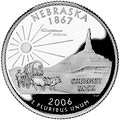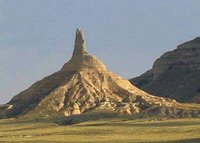History and Old Stuff...
When I was a little girl studying Nebraska in 4th grade, I had never seen Chimney Rock (or Scotts Bluff or any of the other curious rock formations that are scattered across the Platte Valley in Western Nebraska.)
However, I would have recognized Chimney Rock instantly, had I seen it. I had been thoroughly schooled about its distinctive silhouette and its significance as a landmark to travelers across the prairie.
A textbook from the era of my education gives the following description of Chimney Rock:
Out near Bayard, in Morrill County, beside the old Mormon Trail, a huge rock rises from the plain like a giant chimney. It is 120 feet high and is made of clay with layers of red and white sandstone. It can be seen for thirty miles and is now a well-known monument. In the early days, it served as a guide for the travelers who were on their way west.
What a tale it could tell if it could but speak-- a tale of prairie schooners and stagecoach days. A tale of railroads, highways, and of airways!
Not far from this famous landmark passed the travelers along the Oregon and Mormon trails. Past this, too, went the Pony Express riders on their way to the West.
Clara O. Wilson, Alice M. Cusack, and Clara Evans in A Child's Story of Nebraska, published in 1948 by the Lincoln Publishing Company, Lincoln. P. 139.
Scott Bayard, writing for the Associated Press in a July 15, 2006, article titled "Nebraska's Popular Chimney Rock Eroding," says, "An 1830 fur caravan resulted in the first written recorded reference to Chimney Rock and the first artistic rendering that survives dates to 1837. Of the hundreds of letters and diaries from the period, Chimney Rock is mentioned more than any other natural feature."
The westward-bound who reached Chimney Rock surely were grateful for the progress they had made. As they looked to the west, they knew that the easiest miles of the trail were ending and the hard trek through the Rockies was near at hand. Like all milestones in life, it was a moment to look both backward and forward and then to square the shoulders and forge ahead.
 Nebraska's new state quarter has a picture of Chimney Rock and a covered wagon. It was a wise choice because it is a symbol that every native Nebraskan understands and shares. The words "Chimney Rock" bring to mind the crayon sketches and papier mache models we once made of this unique formation.
Nebraska's new state quarter has a picture of Chimney Rock and a covered wagon. It was a wise choice because it is a symbol that every native Nebraskan understands and shares. The words "Chimney Rock" bring to mind the crayon sketches and papier mache models we once made of this unique formation.Furthermore, the Nebraska quarter immortalizes a natural wonder that won't be there forever. The geological forces that gave Chimnney Rock its famous upside-down funnel shape are still at work. As the soft clay layers continue to erode, the long thin "chimney" will gradually crumble away -- or perhaps it will simply break off one day.
So says Scott Bayard in his AP article. I suppose he's right, but perhaps the erosion is affecting the girth of the chimney more than its height.
The following sentences in Bayard's article are curious, considering that the height of the rock was said to be 120 feet in the 1948 textbook I quoted above. "The spire has lost about 30 feet in the past 150 years. It currently measures 325 feet from tip to base, with the spire measuring 120 feet, according to the Nebraska State Historical Society."
I hope I get to see Chimney Rock again while it is still standing. I haven't been out there since I was attending college at Chadron, Nebraska, and was dating a boy from Scottsbluff. That was 1970.
- - - - - - - - - - - -
Images in this post are from Wikipedia
Related Sites:
Photographs of Chimney Rock -- Thirty-five photographs of Chimney Rock from the early 1900s to 1993.
Old postcard photo of Chimney Rock
U.S. Geological Survey photo of Chimney Rock about 1915
Technorati tags:

1 comment:
Post a Comment